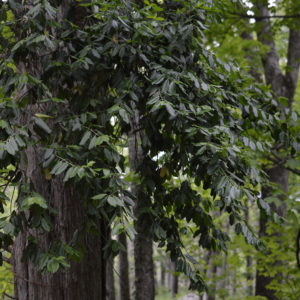Amur Bush Honeysuckle (Lonicera maackii)
 Bush honeysuckle was first introduced into the United States from eastern Asia as a garden ornamental in the late 1800s, and later (1960s-80s) promoted for use in soil stabilization, reclamation, and wildlife habitat improvement projects. Due to its long growing period, and many seeds transported by birds and animals, honeysuckle dominates the forest understory, impacting young trees and crowding out native shrubs such as spicebush, bladdernut, pawpaw, and viburnum. Leafing out early in the spring, honeysuckle creates a dense shade under which our spring ephemerals and other wildflowers and other species decline. Although birds readily eat the red berries, the fruit lacks the fat and nutrients necessary for fall migration and winter health.
Bush honeysuckle was first introduced into the United States from eastern Asia as a garden ornamental in the late 1800s, and later (1960s-80s) promoted for use in soil stabilization, reclamation, and wildlife habitat improvement projects. Due to its long growing period, and many seeds transported by birds and animals, honeysuckle dominates the forest understory, impacting young trees and crowding out native shrubs such as spicebush, bladdernut, pawpaw, and viburnum. Leafing out early in the spring, honeysuckle creates a dense shade under which our spring ephemerals and other wildflowers and other species decline. Although birds readily eat the red berries, the fruit lacks the fat and nutrients necessary for fall migration and winter health.
The Floracliff Board of Directors first took note of the invasion of bush honeysuckle at the sanctuary in the 1990s, and widespread eradication efforts began in 2001. Since then, Floracliff staff and volunteers have removed over 90 acres of bush honeysuckle. Plants are cut at the base, and the remaining stump is treated with a small amount of systemic herbicide.
Wintercreeper (Euonymus fortunei)
 Native to Asia, wintercreeper was introduced as an ornamental groundcover in the United States in the late 1800s. A shade-tolerant, evergreen, woody vine, wintercreeper forms a dense mat that chokes out native wildflowers and excludes seedling regeneration from shrubs and trees. Climbing vines damage and kill trees, and produce large amounts of fruits that are spread by birds, mammals, and water. At Floracliff, we focus on treating vines that are climbing trees and pull and treat vines on the ground as we control other invasives.
Native to Asia, wintercreeper was introduced as an ornamental groundcover in the United States in the late 1800s. A shade-tolerant, evergreen, woody vine, wintercreeper forms a dense mat that chokes out native wildflowers and excludes seedling regeneration from shrubs and trees. Climbing vines damage and kill trees, and produce large amounts of fruits that are spread by birds, mammals, and water. At Floracliff, we focus on treating vines that are climbing trees and pull and treat vines on the ground as we control other invasives.
Garlic Mustard (Alliaria petiolata)
 Garlic mustard is an herbaceous biennial that was introduced from Europe in the 1800s and cultivated for food and medicinal use. Garlic mustard seeds germinate in the spring and form a low-growing basal rosette of leaves that persist through the winter, continuing to grow as long as temperatures remain above freezing. The following spring, the plant produces flowering stalks over an extended period (April-June), followed by slender seedpods that develop quickly. Seeds remain viable in the soil for up to 10 years, and spread easily with the help of gravity, water, and animals (including humans).
Garlic mustard is an herbaceous biennial that was introduced from Europe in the 1800s and cultivated for food and medicinal use. Garlic mustard seeds germinate in the spring and form a low-growing basal rosette of leaves that persist through the winter, continuing to grow as long as temperatures remain above freezing. The following spring, the plant produces flowering stalks over an extended period (April-June), followed by slender seedpods that develop quickly. Seeds remain viable in the soil for up to 10 years, and spread easily with the help of gravity, water, and animals (including humans).
Because it is a cool-season herb and prolific seed-producer, garlic mustard quickly overtakes the niche of our early-spring ephemeral wildflowers. As a member of the mustard family (Brassicaceae), garlic mustard acts as a “population sink” for the West Virginia white butterfly (Pieris virginiensis) that normally lays its eggs on our native spring mustards such as broad-leaved toothwort (Cardamine diphylla), cutleaf toothwort (Cardamine concatenata), and smooth rock cress (Borodinia laevigata). Attracted to the leafy pungent plant, West Virginia white butterflies lay their eggs on garlic mustard, but unfortunately, the caterpillars are unable to mature on this unsuitable plant, and the butterfly population is declining as a result.
At Floracliff we pull garlic mustard beginning in February until the seed capsules open in June. We prioritize working on populations in sensitive habitats first and then move on to more disturbed habitats.
Ornamental Flowering Pear—Callery Pear (Pyrus calleryana)
 Ornamental flowering pear, also known as Callery pear (Pyrus calleryana) is easily recognized by the abundant malodorous white flowers in early spring, and shiny red foliage in the fall. Native to eastern Asia, Callery pear was originally introduced to the United States in the early 1900s with the hopes of combatting fireblight in the common pear (Pyrus communis). A variety of ornamentals were bred, including the cultivars ‘Bradford’, ‘Aristocrat’, ‘Autumn Blaze’, and ‘Chanticleer’. These cultivars readily cross-pollinate, producing prolific fruits that are consumed by birds and mammals, thus spreading the seeds far and wide. The resulting thorn-bearing seedlings quickly invade fence lines, street right-of-ways, fields, and woodlands. In recent years, we have discovered seedlings of this invasive plant in our fields and forests at Floracliff.
Ornamental flowering pear, also known as Callery pear (Pyrus calleryana) is easily recognized by the abundant malodorous white flowers in early spring, and shiny red foliage in the fall. Native to eastern Asia, Callery pear was originally introduced to the United States in the early 1900s with the hopes of combatting fireblight in the common pear (Pyrus communis). A variety of ornamentals were bred, including the cultivars ‘Bradford’, ‘Aristocrat’, ‘Autumn Blaze’, and ‘Chanticleer’. These cultivars readily cross-pollinate, producing prolific fruits that are consumed by birds and mammals, thus spreading the seeds far and wide. The resulting thorn-bearing seedlings quickly invade fence lines, street right-of-ways, fields, and woodlands. In recent years, we have discovered seedlings of this invasive plant in our fields and forests at Floracliff.
Emerald Ash Borer (Agrilis planipennis)
In 2010, Emerald Ash Borer (EAB), an exotic invasive pest insect, was documented in Fayette County. Since its accidental introduction into the United States from north-eastern Asia in the 1990s (likely in wood shipping material), EAB has caused the death of hundreds of millions of ash trees in North America. Adult beetles cause little damage when they feed on newly emerged ash leaves in the spring, or when females lay their eggs on the bark of the trees. When the larva hatches, it bores into the vascular tissue of the tree where it feeds on the inner bark and disrupts the tree’s ability to transport water and nutrients, eventually killing the tree. The larva pupates in the tree, then emerges as an adult in spring, leaving a D-shaped exit hole.
As a leader in conservation in Fayette County, Floracliff first treated its ash trees for EAB in 2011, focusing on trees along the trail system. Treatments continued in 2015, 2018, and 2022, with a total of about 100 individual trees protected. As untreated ash trees succumb to the effects of Emerald Ash Borer, Floracliff acts as a refugium for the native ash trees that are disappearing from our region.
Other invasive exotic plants
We manage a number of other invasive exotic plants at Floracliff. These include privet (Ligustrum vulgare), winged burning bush (Euonymus alatus), multiflora rose (Rosa multiflora), Japanese honeysuckle (Lonicera japonica), Japanese stiltgrass (Microstegium vimineum), Dahurian buckthorn (Rhamnus davurica), tree-of-heaven (Ailanthus altissima), Johnson grass (Sorghum halepense), Chinese yam (Dioscorea polystachya), star-of-Bethlehem (Ornithogalum umbellatum), English ivy (Hedera helix) and more.

